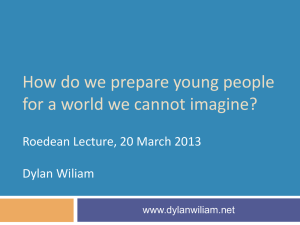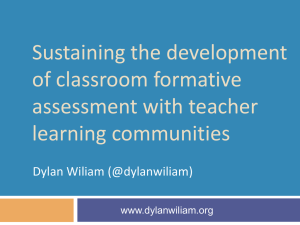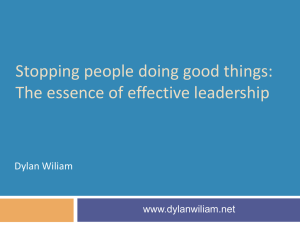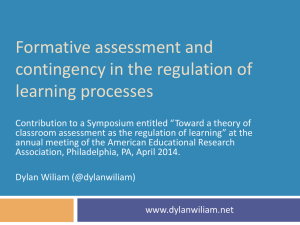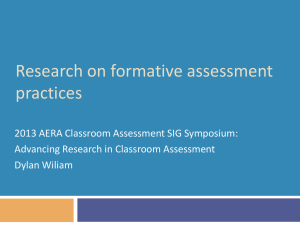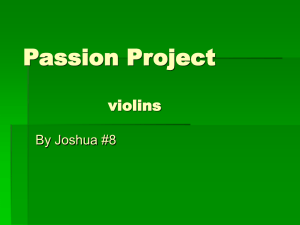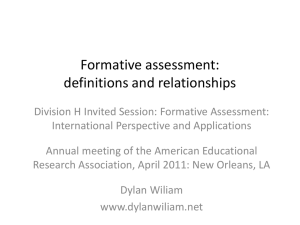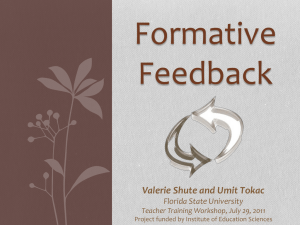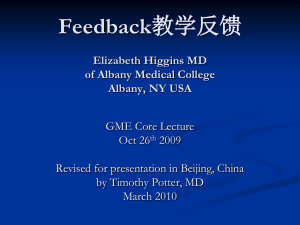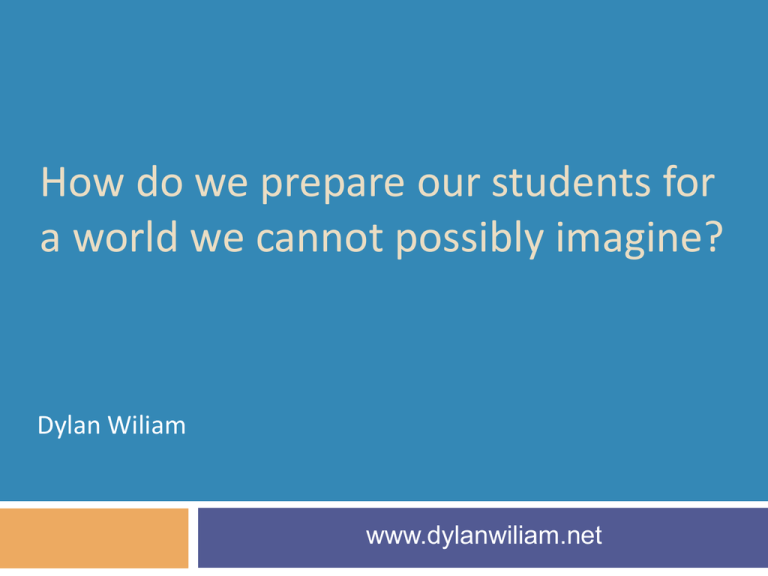
How do we prepare our students for
a world we cannot possibly imagine?
Dylan Wiliam
www.dylanwiliam.net
Overview
2
Why education matters
The changing world of work
The role of teacher quality in improving education
Why most of the strategies being pursued in the
U.S. won’t work
What we should be doing
What is the purpose of education?
3
Four main philosophies of education
Personal empowerment
Preparation for citizenship
Cultural transmission
Preparation for work
All are important
Any education system is a (sometimes uneasy)
compromise between these four forces
Recession (2008-2010) and recovery (2010-2012)
4
Those with a high school diploma or less
lost
5.6 million jobs in the recession, and
lost a further 230,000 jobs in the recovery
Those with an Associate’s degree
lost
1.75 million jobs in the recession, but
gained 1.6 million jobs in the recovery
Those with at least a Bachelor’s degree
gained
187,000 jobs in the recession, and
gained a further 2 million jobs in the recovery
Carnevale, Jayasundera, and Cheah (2012)
The world of work is changing…
Education level
Postgraduate qualification
BA/BSc
Some college
High school diploma
High school dropout
Economic Policy Institute (2010)
Change in salary 1978 to 2005
+28%
+19%
0%
0%
-16%
…in ways that are hard to predict
Skill category
Complex communication
Expert thinking/problem solving
Routine manual
Non-routine manual
Routine cognitive
Autor, Levy & Murnane (2003)
Percentage change 19691999
+14%
+8%
–3%
–5%
–8%
Computers in medical diagnosis
7
Pilot study of the use of neural nets to predict
biopsy
results
cancer recurrence after radical prostatectomy
Samples
1,787
men with a serum prostate-specific antigen
(PSA) concentration > 4.0 ng/ml
240 men who had undergone radical prostatectomy
Prediction accuracy
Specialist
urologists: 50%
Artificial neural nets: 90%
Snow, Smith and Catalona (1994)
Off-shoring and automation
Off-shoreable
Skilled
Radiographer
Security analyst
Tax accountant
Food packager
Unskilled Data entry clerk
Call centre operator
Not off-shoreable
Surgeon (?)
Bricklayer
Hairdresser
Grocery store clerk
Receptionist
Retail salesperson
The coming war for jobs (Clifton, 2011)
Right now
7
billion people on earth
5 billion adults
3 billion people who want to work
90% of these want to work full time
As a consequence
2.7
billion full-time formal jobs are wanted
with only 1.2 billion full-time formal jobs available
A shortfall of 1.5 billion jobs
So, for every US worker, there are 10 people who
would like their job…
Meet Maddie Parlier…
Davidson (2012)
There is only one 21st century skill
11
So the model that says learn while you’re at school, while
you’re young, the skills that you will apply during your
lifetime is no longer tenable. The skills that you can learn
when you’re at school will not be applicable. They will be
obsolete by the time you get into the workplace and need
them, except for one skill. The one really competitive skill is
the skill of being able to learn. It is the skill of being able
not to give the right answer to questions about what you
were taught in school, but to make the right response to
situations that are outside the scope of what you were
taught in school. We need to produce people who know
how to act when they’re faced with situations for which
they were not specifically prepared. (Papert, 1998)
Successful education?
12
The test of successful education is not the amount of knowledge
that a pupil takes away from school, but his appetite to know
and his capacity to learn. If the school sends out children with
the desire for knowledge and some idea how to acquire it, it will
have done its work. Too many leave school with the appetite
killed and the mind loaded with undigested lumps of
information. The good schoolmaster is known by the number of
valuable subjects which he declines to teach.
The Future of Education (Livingstone, 1941 p. 28)
Where’s the solution?
Structure:
Smaller/larger high schools
K–8 schools/“All-through” schools
Alignment:
Curriculum reform
Textbook replacement
Governance:
Charter schools
Vouchers
Technology:
Computers
Interactive whiteboards
Workforce reforms
Pause for reflection
What’s the most interesting, surprising, or
challenging thing you have heard so far?
See if you can get consensus with your neighbors
School effectiveness
15
Three generations of school effectiveness research:
Raw results approaches:
Different schools get different results.
Conclusion: Schools make a difference.
Demographic-based approaches:
Demographic factors account for most of the variation.
Conclusion: Schools don’t make a difference.
Value-added approaches:
School-level differences in value-added are relatively small.
Classroom-level differences in value-added are large.
Conclusion: An effective school is a school full of effective
classrooms.
We need to focus on classrooms, not schools
In the USA, variability at the classroom level is at
least four times that at school level.
As
long as you go to school, it doesn’t matter very
much which school you go to.
But it matters very much which classrooms you are in.
It’s not class size.
It’s not the between-class grouping strategy.
It’s not the within-class grouping strategy.
And most of all, on teachers
17
Take a group of 50 teachers:
Students taught by the most effective teacher in that group
of 50 teachers learn in six months what those taught by the
average teacher learn in a year.
Students taught by the least effective teacher in that group
of 50 teachers will take two years to achieve the same
learning
(Hanushek & Rivkin, 2006)
And furthermore:
In the classrooms of the most effective teachers, students
from disadvantaged backgrounds learn at the same rate as
those from advantaged backgrounds
(Hamre & Pianta, 2005).
How do we improve teacher quality?
A classic labor force issue with two (non-exclusive)
solutions:
Replace
existing teachers with better ones.
Help existing teachers become even more effective.
Here’s what we know about teaching
19
We don’t know who will be good teachers
We can’t tell good teaching:
when
we see it
by looking at “value-added” test scores
The ‘dark matter’ of teacher quality
20
Mathematics
Primary
Middle
Reading
High
Primary
Middle
—
—
+
General theory of
education courses
Teaching practice
courses
Pedagogical
content courses
Advanced
university courses
Aptitude test
scores
Harris and Sass (2007)
+
High
+
—
—
+
Observations and teacher quality
21
Percentage change in rate of learning
Reading
20
15
Mathematics
So, the highest rated teachers are 30%
more productive than the lowest rated
10
5
0
-5
But the best teachers are 400% more
productive than the least effective
-10
-15
Unsatisfactory
Basic
Proficient
Distinguished
Sartain, Stoelinga, Brown, Luppescu, Matsko, Miller, Durwood, Jiang, and Glazer (2011)
So what’s to be done?
Expertise
23
Grandmaster chess players don’t have higher IQs
than average chess players
Top surgeons don’t have higher IQs, medical school
grades, or higher manual dexterity than average
surgeons
In general, measures of general ability account for
4% of the variability in performance
The role of deliberate practice
24
Music professors at the Hochschule der Kuenst (Academy of
Music) Berlin identified 10 violin students who had the potential
for careers as international soloists (“best” students)
The professors also identified a sample of 10 good, but not
outstanding students (“good” students)
Researchers recruited another 10 students training to be music
teachers who specialised in the violin (“Music Ed” students)
An additional 10 middle-aged professional violinists from two
local orchestras were recruited to the study
Groups were matched in sex (7f, 3m) and for the first three
groups, age
How much do violinists practice?
Music Ed
Good
Best
Professionals
Hours of practie per week
35
30
25
20
15
10
5
0
4
9
14
Age
Ericsson, Krampe, and Tesch-Römer (1993)
19
Violinists’ hours of practice (cumulative)
26
Cumulative hours of practice
Music Ed
Good
Best
10
12
Age
Professionals
10000
8000
6000
4000
2000
0
4
6
8
14
16
18
20
These differences are substantial…
27
Hours of practice by age 18
Music Education students
3420
Good violin students
Best violin students
5301
7410
Professional musicians
7336
By the age of 18, the best violinists have accumulated 40%
more practice than good violinists
Since the amount of deliberate practice being undertaken
by the best students once they are adults is close to the
maximum possible, it is, essentially, impossible for the
good students to catch up to the best.
Talent is over-rated…
28
General conclusions about expertise
29
Elite performance is the result of at least a decade of
maximal efforts to improve performance through an
optimal distribution of deliberate practice
What distinguishes experts from others is the
commitment to deliberate practice
Deliberate practice is
an effortful activity that can be sustained only for a limited
time each day
neither motivating nor enjoyable—it is instrumental in
achieving further improvement in performance
Effects of experience in teaching
30
Extra months per year o f learning
1
Mathematics
1
0
0
-1
-1
-2
-2
-3
-3
-4
-4
-5
Years of teaching experience
0
1
2
3 to 5
Rivkin, Hanushek and Kain (2005)
Reading
-5
0
Years of teaching experience
1
2
3 to 5
Implications for education systems
Pursuing a strategy of getting the “best and brightest”
into teaching is unlikely to succeed
Currently all teachers slow, and most actually stop,
improving after two or three years in the classroom
Expertise research therefore suggests that they are
only beginning to scratch the surface of what they are
capable of
What we need is to persuade those with a real passion
for working with young people to become teachers,
and to continue to improve as long as they stay in the
job.
So what should teachers improve?
Formative assessment…
33
Fuchs & Fuchs (1986)
Elshout-Mohr (1994)
Natriello (1987)
Brookhart (2004)
Crooks (1988)
Allal & Lopez (2005)
Bangert-Drowns et al. (1991)
Köller (2005)
Kluger & DeNisi (1996)
Brookhart (2007)
Black & Wiliam (1998)
Wiliam (2007)
Nyquist (2003)
Hattie & Timperley (2007)
Dempster (1991, 1992)
Shute (2008)
… an evolving concept (Brookhart, 2007)
Conceptualization
Information about the
learning process…
… that teachers can use
for instructional
decisions…
…and students can use to
improve performance…
…which motivates
students
Source(s)
Scriven (1967)
Bloom, Hastings and
Madaus (1971)
Sadler (1983; 1989)
Natriello (1987); Crooks
(1988); Black and Wiliam
(1998)
35
“An assessment functions formatively to the
extent that evidence about student
achievement is elicited, interpreted, and used
by teachers, learners, or their peers, to make
decisions about the next steps in instruction
that are likely to be better, or better founded,
than the decisions they would have taken in the
absence of the evidence that was elicited.”
Mapping out the terrain
36
Timescale
Annual
Interim
Weekly
Daily
Hourly
Academic
promotion
Benchmark
Common formative
assessments
Before the endof-unit tests
Exit pass
End-of-course
exams
High-stakes
accountability
Growth
End-ofunit tests
Hinge-point
questions
Instructional
Guidance
(“formative”)
Describing
Individuals
(“summative”)
Function
Institutional
Accountability
(“evaluative”)
Main approaches to formative assessment
Professional Learning Communities
“…an inclusive group of people, motivated by a shared
learning vision, who support and work with each other,
finding ways, inside and outside their immediate
community, to enquire on their practice and together
learn new and better approaches that will enhance all
pupils’ learning.” (Stoll et al., 2006)
Two main approaches
Professional
focused
Teacher
learning communities (PLCs)
on student achievement
learning communities (TLCs)
focused
on improvements in teacher expertise
Complementary processes
38
Data-driven PLCs
Quality control
Common assessments
Improvement through better
team work and systems
Focus on individual outcomes
for students
Regular meetings focused on
data
16 points on PISA (in two to
three years)
Classroom FA TLCs
Quality assurance
Highly structured meetings
Improvement through
increased teacher capacity
Focus on teachers’ individual
accountability for change
Regular meetings focused on
teacher change
30 points on PISA (in two to
three years)
Unpacking classroom formative assessment
39
Where the
learner is going
Teacher
Peer
Learner
Clarifying,
sharing and
understanding
learning
intentions
Where the learner is How to get there
Providing
Engineering effective
discussions, tasks, and feedback that
moves learners
activities that elicit
forward
evidence of learning
Activating students as learning
resources for one another
Activating students as owners
of their own learning
Examples of techniques
Learning intentions
“sharing exemplars”
Eliciting evidence
“mini white-boards”
Providing feedback
“match the comments to the essays”
Students as owners of their learning
“colored cups”
Students as learning resources
“pre-flight checklist”
And one big idea
41
Where the
learner is going
Teacher
Peer
Learner
Where the learner is How to get there
Using evidence of
achievement to adapt what
happens in classrooms to
meet learner needs
So much for the easy bit
A model for teacher learning
43
Content, then process
Content (what we want teachers to change):
Evidence
Ideas
Science
(strategies and techniques)
Process (how to go about change):
Choice
Flexibility
Small
steps
Accountability
Support
Design
Supportive accountability
44
What is needed from teachers:
A
commitment to:
The
continual improvement of practice
Focus on those things that make a difference to students
What is needed from leaders:
A
commitment to engineer effective learning
environments for teachers by:
Creating
expectations for continually improving practice
Keeping the focus on the things that make a difference to
students
Providing the time, space, dispensation, and support for
innovation
Supporting risk-taking
Teacher learning communities
46
We need to create time and space for teachers to
reflect on their practice in a structured way, and
to learn from mistakes.
Bransford, Brown & Cocking (1999)
“Always make new mistakes.”
Esther Dyson
“Ever tried. Ever failed. No matter. Try again. Fail
again. Fail better.”
Beckett (1984)
Summary
47
Raising achievement is important
Raising achievement requires improving teacher
quality
Improving teacher quality requires teacher
professional development
To be effective, teacher professional development
must address:
What teachers do in the classroom
How teachers change what they do in the classroom
Classroom formative assessment + teacher learning
communities:
A point of (uniquely?) high leverage
Thank you

